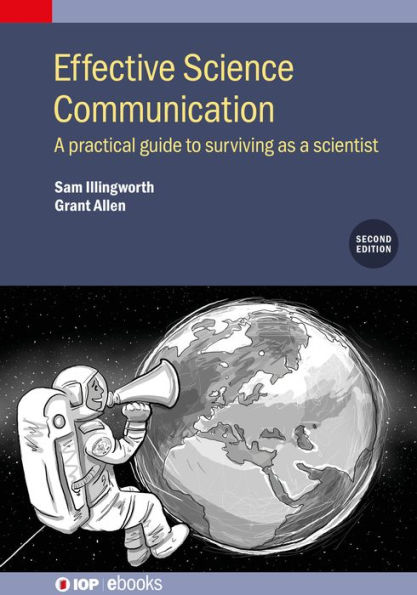Being a scientist in the 21st century can be extremely demanding. In addition to conducting exceptional research we are expected to communicate it effectively to a variety of audiences, from scientists and students to policymakers and press officers.
This book provides a roadmap for how to disseminate your research findings in an engaging manner via a range of channels, such as scientific publications, press releases, social media and outreach. Furthermore, by providing advice and worked examples on how to fund and publish your research, develop additional skills and support inclusive practices, this book provides a comprehensive handbook for how to be a successful scientist.
This second edition brings the text up to date and includes additional material, while retaining the combination of clear insight and practical advice that made the first edition essential.
The cliché is that scientists are not good communicators. Even so, it is rare to read a book that is evidently useful from the title, that is obvious in retrospect but only in retrospect, that provides new information and is a joy to read. For graduates of the school of hard knocks (i.e., life), much of the information in the book has already been (sometimes painfully) learned or is a head slapper. But for those more junior, the book does an outstanding job at providing both a roadmap and detailed set of instructions on when and how to best communicate.
A few to-be-expected (but highly useful) chapters deal with writing research papers, seeking funding and presenting at conferences, after which the book delves into outreach, communicating to media and working with policy makers. Each chapter has hands-on “exercises” that get the reader to practice some of the newly acquired skills, such as write a blog, prepare for peer review or develop an audience plan for a talk. Each chapter also includes charts, checklists, resources for further study, suggested readings and a formal set of references. For those past the middle of their careers, if there were a time machine available, this is one book worth sending to a younger self. And for those just starting a career in science, or for just about anybody without a degree in communications, this is one book that should be required reading.
Bogdan Hoanca 2020 Optics & Photonics News, The Optical Society, USA
Being a scientist in the 21st century can be extremely demanding. In addition to conducting exceptional research we are expected to communicate it effectively to a variety of audiences, from scientists and students to policymakers and press officers.
This book provides a roadmap for how to disseminate your research findings in an engaging manner via a range of channels, such as scientific publications, press releases, social media and outreach. Furthermore, by providing advice and worked examples on how to fund and publish your research, develop additional skills and support inclusive practices, this book provides a comprehensive handbook for how to be a successful scientist.
This second edition brings the text up to date and includes additional material, while retaining the combination of clear insight and practical advice that made the first edition essential.
The cliché is that scientists are not good communicators. Even so, it is rare to read a book that is evidently useful from the title, that is obvious in retrospect but only in retrospect, that provides new information and is a joy to read. For graduates of the school of hard knocks (i.e., life), much of the information in the book has already been (sometimes painfully) learned or is a head slapper. But for those more junior, the book does an outstanding job at providing both a roadmap and detailed set of instructions on when and how to best communicate.
A few to-be-expected (but highly useful) chapters deal with writing research papers, seeking funding and presenting at conferences, after which the book delves into outreach, communicating to media and working with policy makers. Each chapter has hands-on “exercises” that get the reader to practice some of the newly acquired skills, such as write a blog, prepare for peer review or develop an audience plan for a talk. Each chapter also includes charts, checklists, resources for further study, suggested readings and a formal set of references. For those past the middle of their careers, if there were a time machine available, this is one book worth sending to a younger self. And for those just starting a career in science, or for just about anybody without a degree in communications, this is one book that should be required reading.
Bogdan Hoanca 2020 Optics & Photonics News, The Optical Society, USA

Effective Science Communication (Second Edition): A practical guide to surviving as a scientist
200
Effective Science Communication (Second Edition): A practical guide to surviving as a scientist
200Related collections and offers

Product Details
| ISBN-13: | 9780750325202 |
|---|---|
| Publisher: | Institute of Physics Publishing |
| Publication date: | 05/07/2020 |
| Series: | IOP ebooks |
| Sold by: | Barnes & Noble |
| Format: | eBook |
| Pages: | 200 |
| File size: | 10 MB |
